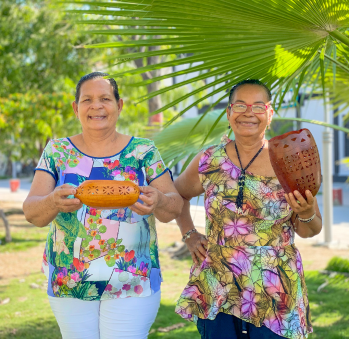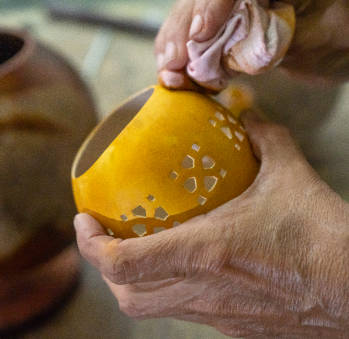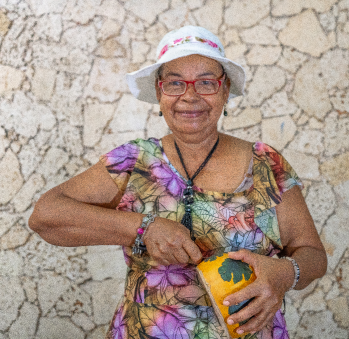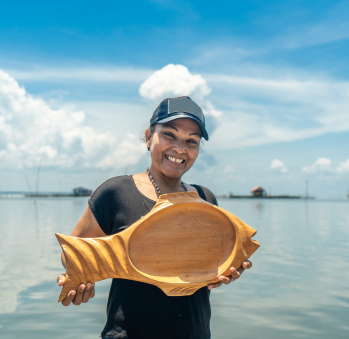Diva, Zuly, Hermelinda, Elid
Workshop: Totumo Republicano
Craft: No maderables
Trail: Magdalena Route
Location: Ciénaga, Magdalena
“Diva is only laughter. And contagious at that. She stares with her joyful eyes and speaks with the cadence of water, which surrounds her in her cienaguero landscape. Along with her craftswomen partners, among which Zuly peeks out, she makes wares in totumo: that beautiful fruit that hands from trees that grow in banana-growing regions and that populate this part of the department of Magdalena. Entire generations have used it as a container with which to bathe “a totumazos,” as well as to serve the rice, to eat soup and chocolate, to use as a spoon, to eat mazamorra, to strain coffee, to grind achiote, and even to play when children turn it into the shell of the morrocoya turtle. They all say that the totumo was used because the few pewter plates and cups that they had in their houses were exclusively for guests. They claim that the tree is so generous that its flowers and pulp have been used for years as medicine for the flu and other ailments, and even to dye their hair.
With these lifelong memories, this warm woman tells us about her Ciénaga Grande: the home she loves so much. She invites us to come to this place because of its beautiful marshy terrain full of herons, ducks, storks, condors, and great curassows that announces a change of scenery between flatlands and coasts. There, freshwater subterranean rivers, some cold and some warm, endless if not disturbed, will finally reach the Carribean Sea. It will be the wonderful transition between the muddy waters of the Magdalena River that will connect with the cold waters of the Toribío, Frío, and Córdoba rivers and flow into and be purified by sea salt. Diva, as if we didn’t already have enough beauty in this journey, mentions the Totumo Volcano, with its magnificent hot springs. She basks in saying that it is additionally close to the Sierra Nevada de Santa Marta. Its only drawback: the proximity to coal, which makes its beaches dirty.
She enjoys living in the midst of this landscape. For some years now, she and her companions, Zuly, Hermelinda and Elid, have undertaken the task of earning their sustenance from this abundant raw material, turning it into handicrafts. Thanks to workshops offered both by the Sena institue and Artesanías de Colombia, they have been able to see decorative wares in the totumo fruit that go beyond its well-known usefulness. And, even though the preparation process of the raw material has changed very little over the years —since it still consists of harvesting, drying, grilling, and pulping—, what has happened is that they have learned ornamental techniques. One of them is the openwork with which they perforate the fruit to make drawing patterns. These include the designs of the Republican balconies that can still be seen in the region, as well as the town’s leaves and flowers, like the Catleya with which they decorate flowerpot holders and other household wares.
When they harvest, these women take pictures of nature and architecture. They then take those designs and make them into templates. They later work with them by hand with cutters they make and with which they shape the totumo. They have badly injured themselves more than once while doing their openwork, but this has not decreased their desire to keep on creating. What’s more, like alchemists, they have learned to color and mix natural dyes that come from achiote, mangle, avocado seeds and carrots together with industrial dyes that fix better. They do not get tired, so they are also making jewelry, carved necklaces and earrings, always praying for the totumo not to break at the last second (because it sometimes happens and brings a tear to their eyes.) Even so, they give each other company and, fortunately, they have laughter in abundance, so they make the best of bad times. And they continue going on. “
Craft





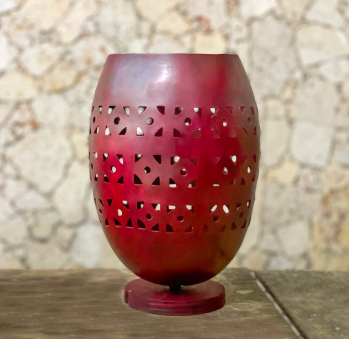






Artisans along the way
Artisans along the way
No puede copiar contenido de esta página








































